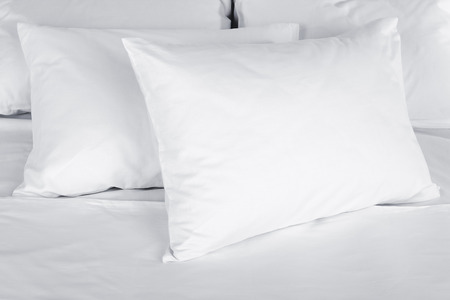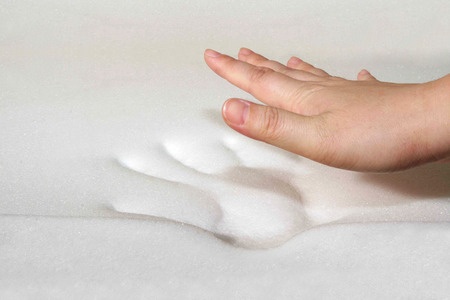Pillow Essentials
All You Need to Know to Find the Perfect Pillow for You

Most people underestimate how crucial pillows are to a good night’s sleep. When it comes to sleep comfort, everything depends on getting proper support for your head and neck. Without it, aches, pains, and stiffness are the all-too-likely results. You could have the most comfortable mattress money can buy, topped with the softest, most luxurious sheets – but if your pillow isn’t doing the job, you might as well be sleeping on a pile of gravel.
One reason pillows fall short is that they’ve simply given all they have to give. Most pillows typically need replacing after about two or three years, give or take, depending on the quality of the pillow. A good, well-made down pillow for instance could last as much as five years or more, while the lifespan of a bargain basement synthetic might be measured in months.
If all this seems a bit extreme to you, consider that pillows live a hard life. They get smashed and flattened out over time supporting the weight of your head every night. They get rolled over, tossed around, crumpled, and punched. They absorb sweat and become habitats for microorganisms. A pillow is not forever.
Choices, Choices
What kind of pillow you want will depend on what kind of sleeper you are. If you sleep mostly on your back, you’ll want moderate support that doesn’t put too much pressure on your neck, so a medium firm pillow is in order. For side sleepers, it’s particularly important to keep the neck and spine nice and lined up, so you need something that’s fairly firm and shape-conforming. Stomach sleepers tend to like to scrunch their pillows into a little mound, so you’ll need something softer and not too thick – a pillow that gently supports the head while being comfortable enough to put your face in.
But since no one in reality spends the entire night in just one sleep position, consider all this as more of a starting point than a set of hard rules. We all have unique body architectures and personal preferences that defy categories, so ultimately you’ve just got to go with what feels right to you. Some people may also find that what worked for them a few years ago doesn’t quite do it today.
Another thing to consider is what thickness you like. If your mattress is on the firm side, you’ll probably want a thicker pillow to go with it. Likewise, a thinner pillow usually goes better with a softer mattress. Your body size is a factor too: If you’re a larger person, you’ll likely want a thicker pillow.
The most important thing about a pillow is what’s inside – better known in the business as “the fill.” The big decision here is whether you want a natural fill or synthetic. Natural fills such as down offer supreme comfort. The main advantage of synthetics, aside from price, is that they are hypoallergenic (more on this in a moment).
Down and Feather Pillows
A down pillow is considered the ultimate in comfort and luxury. Down comes from the soft, fluffy under plumage of birds that grows underneath their outer layer of feathers. It helps keep birds like waterfowl warm and dry. When it comes to pillows and bedding, we’re talking about either goose down or duck down (eiderdown from the eider duck is a very special, highly sought-after variety.)
The best down comes from cold, northern regions where birds need to develop plenty of insulation. Most down these days comes from China (70%) with the rest mostly coming from Canada and Europe. Hungarian and Polish down are particularly coveted by down aficionados.
Down pillows have a magic ability to somehow be both firm and soft at the same time. They give you all the support you need, yet they have a gentle, airy, almost cloud-like feel under your head. You can work them into just the right shape to match your contours. And if you take good care of them, they’ll last a whole lot longer than synthetic pillows.

Feather pillows can be soft and supportive, but they’re not quite in the same league as down. They feel heavier and less lofty and don’t have the same excellent shape-shifting abilities of down. Another thing about feathers is that the quills sometimes like to poke out. But if you make sure to get a pillow made with a high-quality covering, this shouldn’t be an issue.
Pillows that use a blend of down and feathers are a great way to get most of the feel of down at a more budget-friendly price. The best pillows are filled so that the feathers are in the core of the pillow with the loftier down surrounding it. Something in the range of a 50/50 to 75/25 down/feather blend is a good compromise. If you like a firmer pillow, you may actually prefer this to pure down.
The quality of a pillow is usually measured by its “fill power.” This number is just the amount of space in cubic inches taken up by one ounce of fill. So if a pillow has a fill power of 650, it just means that one ounce of its fill will take up a volume of 650 cubic inches. This is one of your the-higher-the-number-the-better things. A down pillow with anything over 500 is considered good quality. Anything over 850 is exceptional and usually $$$$.
A high fill power means high quality and indicates that the down has come from healthy, mature birds. In practical terms this means the pillow is going to hold its shape better, provide more comfort, and last longer. It’s important to understand that fill power doesn’t have anything to do with a pillow’s firmness or softness. That’s more a function of the pillow’s “fill volume,” the quantity of fill stuffed into a pillow of a given size.
When to Wash
If your pillows are machine washable, you really should do this regularly – say, every three or four months. Most pillows – including down and feather – will go in a washer and dryer with no problem. The usual exception is foam pillows, which tend to get torn when they get wet in machines. Front load washers are usually better for pillows than top loaders, as agitators can be a bit rough. Always be sure to read and heed the pillow’s care label before you do anything.
Allergy Issues
The big disadvantage of down and feather pillows has always been their irksome effect on allergy sufferers. There’s actually some interesting new research out suggesting that in most cases, what causes the reaction is not the down or feathers themselves but what might be in them: dust, dander, microbes, and even mold. Taking good care of your pillows and storing them in a clean, dry place will usually make a big difference here. And if a down pillow has been around for many moons, it may be best to retire it.
There are several products now on the market that use “hypoallergenic down,” meaning the down has been cleaned or sanitized in some way to remove as much of the allergens as possible. This usually entails a series of repeated wash and rinse cycles and vacuuming or “de-dusting” processes that take place before the down goes in the pillow. This can be very effective. Of course, if your allergy really is to the down itself, all the cleaning in the world isn’t going to change that. But if you’ve always avoided down pillows because of allergies, and you wished that you could experience their blissful comfort, this may be worth checking out.
If you’re looking for natural alternatives to down or feathers that are less likely to provoke allergies, wool and cotton both make excellent choices. Cotton is soft, breathable, and provides good support as a fill material. But it does have a tendency to flatten out over time. Wool may be a better choice if you need something really firm and supportive. If your allergies put the kibosh on natural fills altogether, you’ll need to look at synthetics.
Synthetic Pillows
Synthetics make a good alternative to natural fills. As a group, they provide excellent comfort, support, and value. And of course, they are hypoallergenic. The basic choices here are polyester fiberfill, memory foam, or latex foam. Synthetics generally are going to be firmer than natural fills while being significantly less durable.
Fiberfill pillows are probably the most common and familiar to most people. Compared to latex and memory foam, they are lighter and usually a little softer, so if you value huggable comfort over firm support, this may be the way to go. They’re also a good choice if you change sleep-positions frequently though the night or if you are a stomach sleeper. Fiberfill is the most affordable of any type of pillow – but also the least durable and long-lasting. They have a tendency to flatten and get lumpy over time.
To enhance its feel and breathability, fiberfill is sometimes blended with cotton fill or some other natural material. Another variation to look for is “down alternative” pillows which use fine puffs or clusters of polyester designed to give the feeling of true down. “Poly-clusters” are sometimes coated with silicone to prevent them from clumping together and causing lumps.

Memory foam pillows are a new, high-tech alternative. Memory foam is famous for its ability to mold itself to any shape and then gradually return back to its original form when you remove pressure. Besides looking really cool when you put your handprint in it, there are some definite comfort advantages here. It provides excellent head support without creating pressure points, while keeping your head and neck in good, straight alignment – important if you’re a side-sleeper.
Pillows that use shredded memory foam instead of a foam block are a good way to get the advantages of the material with perhaps a more pillow-like feel. There are also hybrid pillows that use a memory foam core surrounded by more traditional materials like down or fiberfill. Memory foam pillows have been known to give off a slight chemical smell when brand-new, but most people find that this goes away after a good airing out.
There’s one other thing about memory foam, and we can almost hear you saying it already: it doesn’t breathe well and tends to sleep hot. Pillow makers have tried a couple of fixes for this with varying degrees of success. Most foam today is manufactured with small holes molded in to provide some air circulation. Gel pillows have little beads or packets of heat-absorbing gel imbedded in the foam to dissipate head buildup and keep things cool. Gel is also available with other fills such as polyester fiberfill.
Latex foam has many of the same qualities and advantages of memory foam but with significant differences. Like memory foam, it’s a good choice for side-sleepers or anyone who needs firm support and relief from neck pain. It has good contouring abilities, but acts more like a conventional foam, springing back immediately to its original shape. One thing people often notice about latex foam is that the pillows tend to be unusually thick and heavy – you won’t want to use one in a pillow fight unless you mean business!
The biggest advantage of latex foam may be that, unlike other synthetics, it actually has good breathability and heat dissipation properties. It may also have an edge when it comes to resisting microbes. The two basic types are Talalay and Dunlop, which use two different manufacturing processes. Dunlop will normally be firmer and give more support than Talalay. Most latex is made synthetically but natural latex is available too.
As with memory foam, latex can also be had in a shredded foam fill. Some even allow you to add or subtract fill to customize firmness. There are also shredded latex and memory foam hybrids. One disadvantage of latex pillows may be cost: They can be on the expensive side, especially if you’re going with natural. Also, be aware that even though latex is highly resistant to allergens, there are rare cases of people who have severe allergic reactions to the latex itself.
Latex and memory foam both are usually not machine-washable but most come with a removable cover that can be thrown into the wash, while the foam can be spot cleaned.
Cover Materials
Once you’ve decided on a fill, you need to consider the cover material that goes around it. Choices range from cotton, polyester, microfiber, rayon (including rayon from bamboo), all the way to luxurious silk. The cover material is important because it keeps the fill from escaping (especially important with down and feathers) while protecting it from outside dirt, dust, and body oils.
What you want to look for are covers with high thread counts, since tightly-woven fabrics are less penetrable. And they should be sewn together with good, robust seams. A separate pillow protector may not be a bad idea for a little added insurance. These go on right between the pillow and the pillow case to keep the pillow extra clean and increase its lifespan.
What’s the Deal with Bamboo?
Bamboo textiles have found their way into the bedroom in the last few years, from bamboo sheets to bamboo pillows (which typically use the material in their outer coverings). But there’s still quite a bit of confusion about what bamboo is and what its benefits are.
Most of what’s been marketed as bamboo is, in fact, viscose rayon. Rayon is a manmade fabric usually made out of wood pulp. But in bamboo textiles, the rayon is made out of bamboo pulp instead. This is said to be more ecofriendly and sustainable than other fabrics like cotton because bamboo grows readily on marginal land using relatively little water or pesticides. The problem with this is that the harsh chemicals used to process the bamboo into rayon, along with the resultant air emissions, mostly renders these benefits negligible. (There is a technique that uses mechanically processed bamboo instead of chemicals. It’s similar to how flax is made into linen and sometimes called “bamboo linen.”) Bamboo has also been marketed as having special antibacterial properties, which is theoretically true, but once it’s been turned into rayon most of this has been processed out.
You’ve sort of got to hand it to these companies for finding a way of making boring old rayon seem like the latest thing! The Federal Trade Commission, however, has started going after retailers who market “bamboo” products if they don’t use mechanically processed bamboo or specify that it’s rayon made from bamboo. None of this is to say that there’s anything wrong with bamboo-based rayon as a fabric for pillow covers. Just understand that you’re not going to save the world by buying it.
Sizes
Pillow sizes usually come in “Standard”, “Queen”, and “King.” These equate right to the conventional U.S. bed sizes (one standard goes on a twin bed, two standards go on a full-size bed, two queen pillows on a queen-size bed, etc.). But there’s no law that says you can’t use any size pillow you want: a standard pillow in a king-size bed or a king on a full-size bed – go nuts! Many people use multiple pillows to arrive at just the right feel. Also, don’t get hung up on the idea that you and your bed-partner must have identical pillows of the same size and thickness for fear that you will offend the symmetry gods. When the bed is made, you can cover up the mismatched pillows with a few shams or decorative pillows.
| Standard: | 20″ x 26″ |
| Queen: | 20″ x 30″ |
| King: | 20″ x 36″ |
| Euro: | 26″ x 26″ |
“Euro” pillows which are 26″ x 26″ (sometimes called “square” or “continental” pillows) are mostly used for décor when the bed’s made up, but they’re also good for propping yourself up if you like to read in bed.
